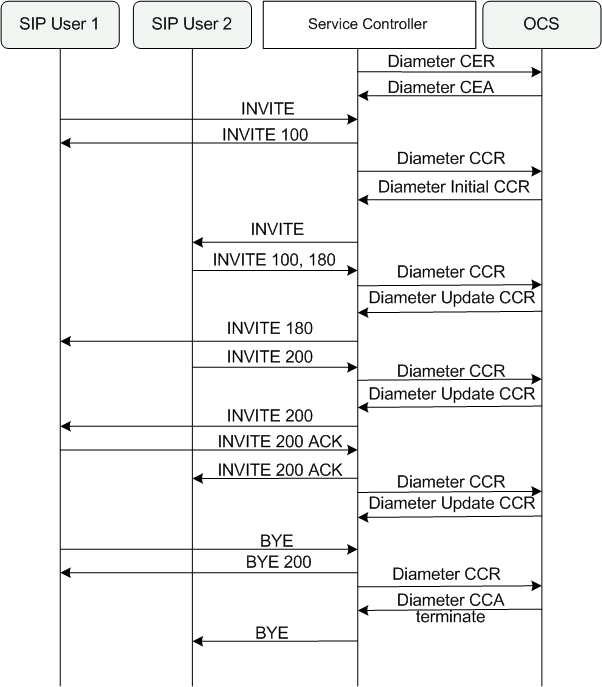5 Setting Up Online Charging Solution for IMS Networks
This chapter describes the Oracle Communications Service Controller and Oracle Communications Online Mediation Controller online charging for IMS networks solution and how to configure Service Controller and Online Mediation Controller for this solution.
About the Online Charging Solution for IMS Networks
You use the online charging for IMS networks solution to deliver Diameter-based charging for subscriber sessions in an IMS network. Service Controller deliver SIP sessions to online charging systems (OCSs) including third-party charging systems supporting the Diameter Ro protocol.
Service Controller supports online charging for IMS networks with a connection to an OCS through the Diameter Ro protocol.
Figure 5-1 shows the basic session charging flow of the online charging for IMS networks solution.
Figure 5-1 Basic Call Flow in SIP to OCS Solution

Description of ''Figure 5-1 Basic Call Flow in SIP to OCS Solution''
Figure 5-2 shows the components in the Service Controller and Online Mediation Controller processing tier that you set up to enable charging of SIP sessions by an OCS.
The IMASF-SIP Service Controller module translates the SIP messages into an internal format used by the Orchestration Engine.
The IMOCF module translates internally formatted messages to Diameter Ro messages processed by the OCS. The SSUs are not included in the figure. See Service Controller Signaling Server Units Configuration Guide, for more information about configuring SSUs.
Sessions flow from the SIP applications through the components in the following order:
-
IMS Network
-
SSU SIP
-
IMASF-SIP
-
Orchestration Engine
-
Ro
-
OCS
Figure 5-2 Components Required for SIP Session Charging by OCS

Description of ''Figure 5-2 Components Required for SIP Session Charging by OCS''
Responses from the OCS flow in the reverse direction through the same components
Enabling OCS Charging of SIP Sessions
An end-to-end configuration enabling SIP charging by a Diameter Ro OCS, requires configuration of SSU SIP, SSU Diameter, IMASF, IMOCF and orchestration engine rules.
To set up this configuration:
-
Enable Service Controller to accept SIP sessions. See "Setting Up Connectivity to the IMS Network" for information about the components that you need to configure and how to configure them.
-
Install and create an Online Mediation Controller domain. See Service Controller Installation Guide, for more information.
-
Route sessions that arrive from the IMS network to the OCS. See "Defining a Service Orchestration Chain" for more information.
Setting Up Connectivity to the IMS Network
To enable the Service Controller SIP interface, perform the configuration steps indicated in the following sections:
-
See "Enabling Acceptance of Incoming Initial SIP Messages", for information on enabling Service Controller to accept initial SIP messages.
-
See "Configuring the RIMASF-SIP Module", for information on deploying the RIMASF-SIP module.
-
See "Routing Incoming Initial SIP Messages to the RIMASF-SIP Module", for information on routing the initial SIP message to RIMASF-SIP
Enabling Acceptance of Incoming Initial SIP Messages
To enable Service Controller to accept incoming initial SIP messages, configure each server in the signaling tier as a SIP network access point.
In the Administration Console:
-
In the navigation tree, expand the OCSB node, then the Signaling Tier node.
-
Select the SSU SIP node.
-
In the SIP tab, in the SIP Configuration tab, select the Network Access Points tab.
-
Click the Add button. The New dialog box appears.
-
Enter an alpha-numeric name for the newly added network access point. Click Apply. A new network access point appears in the tree.
-
Select the recently added network access point.
-
In the General tab, in the Target field, enter the name of the server and click Apply.
-
Select the Listen Address tab, configure the Host and Port of the network access point, and click Apply.
-
Select the External Listen Address tab. If you are using a Load Balancer in your system, configure the Host and Port of the Load Balancer. Otherwise, configure again the Host and Port of the network access point.
Repeat steps 4 through 9 for every server in the signaling tier.
For more details about configuring network access points in the SSU SIP, see the chapter about the SSU SIP in Service Controller Signaling Server Units Configuration Guide.
Configuring the RIMASF-SIP Module
Configure and deploy the RIMASF-SIP instance as described in the chapter on setting up RIMASF-SIP in Service Controller Modules Configuration Guide.
Routing Incoming Initial SIP Messages to the RIMASF-SIP Module
To route incoming SIP messages from your SIP applications to the RIMASF-SIP module, you configure incoming routing rules in the SSU SIP.
In the Administration Console:
-
In the navigation tree, expand the OCSB node, then the Signaling Tier node.
-
Select the SSU SIP node.
-
In the SSU SIP tab, select the Incoming Routing Rules tab.
-
Click the New button. The New dialog box appears.
-
In the Name field, enter a name for the rule.
-
In the IP Address field, enter the address of your SIP application.
-
In the Alias field, enter the alias of the RIMASF-SIP module that you want to process the messages from your SIP application. Enter ssu:RIMASF-name.RIMASF@domain where RIMASF-name is the name that you gave to the RIMASF module when you deployed it, and domain is the name of the processing domain where the module is deployed.
For more details about configuring incoming routing rules in the SSU SIP, see the chapter about the SIP SSU in Service Controller Signaling Server Units Configuration Guide.
Setting Up Connectivity to the OCS
See "Setting Up Connectivity to the OCS" for information on connecting Service Controller to a Diameter Ro OCS.
Defining a Service Orchestration Chain
To route sessions to the OCS, you have to choose the method (LSS, HSS, or static service orchestration) that you want to use for service orchestration, and then, based on your choice, define a service orchestration chain with the OCS in it.
See "Configuring Service Orchestration" for information about the different options for service orchestration, and how to configure them.